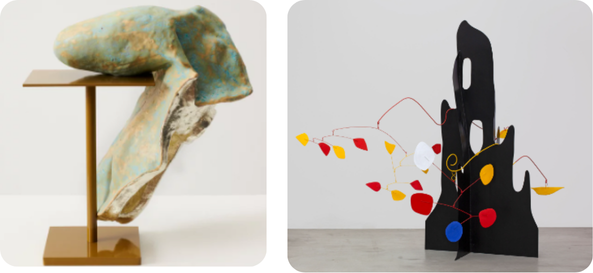Brief: Multi Material Project
Objective
Create a non functional ceramic piece that explores a new artistic direction for you. The work must have a defined concept inspired by other sources. It should incorporate an additional material. Examples: thread, wood, metal, or a found object (if you are a creative hoarder this is a great time to use some of the things you kept just ‘incase’ you might need it, absolutely not speaking from personal experience).
Shane Keeling
The goal is to push your creative boundaries by experimenting with new forms, textures, and combinations of materials. Non ceramic material to be included at end of firing process and can not be incorporated before due to health and safety risks.
Definition of Found Object:
A "found object" is a natural or manufactured item not originally intended for artistic use but repurposed within an artwork. Examples include driftwood, old tools, textile fragments, or discarded household items.
Questions to Ask Yourself
Do you have a notebook for ideas and notes? if not, why? :D
What kind of artists do you like? Why?
Are there any particular sculptural artists that inspire you?
What issues in the world resonate with you right now and evoke strong emotions?
Are there any themes or issues you would like to address in your work?
How do you feel about art for arts sake?
Arlene Shechet / Alexander Calder
Artists to view as a starting point:
Ai Weiwei: Famous for his thought-provoking use of found objects.
Arlene Shechet. Shechet mixes materials such as wood and metal with her ceramics. Her sculptures play with balance and form, contrasting the organic nature of clay with more rigid, industrial materials.
Alexander Calder: Renowned for his kinetic sculptures and innovative use of metal and wire.
Conceptual Plan
Define what you want to create. This should be a planned design, not an improvised one. Decide on the shape, size, and structure of your ceramic piece and how the additional material will be incorporated. Be intentional with your design choices. Use your notebook! I WANT TO SEE DRAWINGS!!!!!!!!!!!!!!!
Antony Gormley
Material Choices: Your final piece must incorporate an additional material. Think about how these materials will contrast or complement the ceramic form and your works agenda if any.
Planning Integration: Consider how you will attach or integrate this material with your ceramic piece. Will it be woven, attached with glue, mechanically fastened, or something else? Ensure the connection is both durable and fits your narrative.
Material Choices: Your final piece must incorporate an additional material. Think about how these materials will contrast or complement the ceramic form and your works agenda if any.
Planning Integration: Consider how you will attach or integrate this material with your ceramic piece. Will it be woven, attached with glue, mechanically fastened, or something else? Ensure the connection is both durable and fits your narrative.
Alexander Millar
Sketch Your Design:
Create detailed(ish) sketches showing at least two views (front and side). Include measurements and consider the scale. Why is it this size? What is the relationship between the size of the ceramic piece and the additional material?
Explain Your Choices:
Write a few lines explaining your design choices. Why did you choose this form, size, and shape? What message or feeling do you hope to convey? How does the additional material enhance the meaning or aesthetics of your work?
Roundtable Discussion: aka the group crit.
For anyone interested in working on this brief, we will have a chat at our first class back, and a few minutes at the beginning of each class. Be prepared to share your research and ideas. This is a great opportunity to receive feedback and refine your ideas before beginning the project. You also don't have to participate in this section if you dont want to. We can/ will also have a little chat one on one.
Maquette: Yes please.
A maquette is a small-scale model of a larger sculpture or artwork. It is used to visually plan and experiment with the design before creating the final piece. Creating a maquette helps you work out potential problems, such as glaze, balance, structure, or proportions, and allows you to make adjustments before committing to the full-sized version. This step can save time and materials while ensuring a successful final outcome.





